These monsters are real
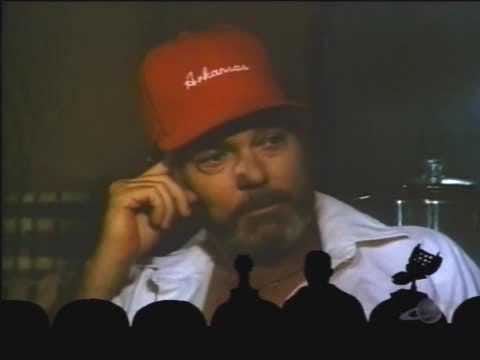
October is the only month where I watch scary movies. I love scary movies, but I need the festiveness of Halloween to cushion my nerves from their effects. Sometimes, if I’m really in a jumpy mood, I need to go a step further and watch campy horror films so that I can laugh at how poorly they try to scare me. That may have been why this past weekend, instead of watching Hereditary like I originally planned, I chose to watch the Mystery Science Theater 3000 episode that featured the film Boggy Creek II: And the Legend Continues.
Boggy Creek II was the third of five movies made about the legend of the Fouke Monster, a bigfoot-like creature that was spotted around southeast Arkansas in the early 1970s. Most of the films were made by Charles Pierce, a local ad man who shot commercial footage for a farm equipment company. He borrowed $100,000 from the company he shot commercials for in order to finance the original film about the legendary monster, The Legend of Boggy Creek. He cast the movie with locals from Fouke, Arkansas and shot the movie himself on an old 35mm camera with local high school students acting as his crew. Surprisingly, the movie ended up making over $20 million and spawned four sequels. Today it and its sequels, especially the beloved Boggy Creek II, survive as cult horror classics.
While The Legend of Boggy Creek may be the most financially successful thriller shot in Arkansas, it wasn’t the first. At the end of 1969, before anyone had ever laid eyes on the Fouke Monster, let alone made a movie about it, a major motion picture from Lorimar Productions was shooting in and around Hot Springs with a $2.5 million budget. And it was more frightening than any monster or beast could ever be.
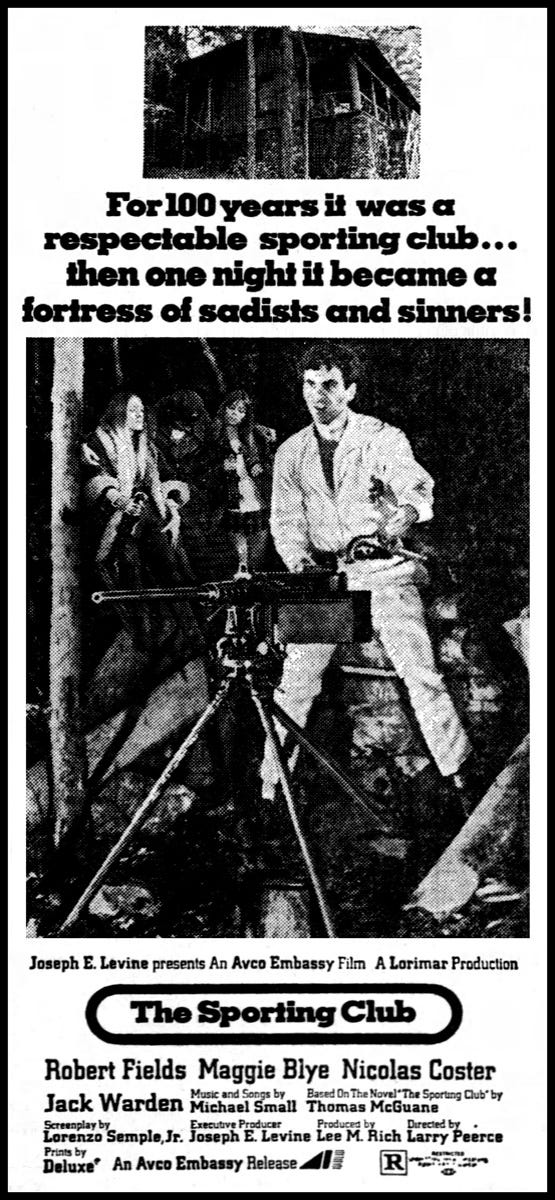
Fresh off the success of Goodbye, Columbus, his 1969 film adaptation of Philip Roth’s novella, Larry Peerce was cashing in his Golden Globe Best Director nomination for a chance to make a much edgier movie. He chose a screenplay based on Thomas McGuane’s novel “The Sporting Club,” a dark and sadistic story of an elite hundred year old hunting club for millionaires in Detroit. Finding that the lakes around the Michigan wilderness where the book was set were all iced over when he wanted to shoot, Peerce chose Lake Sylvia in the Ouachita National Forest right outside of Hot Springs.
His crew set up camp in the Velda Rose motel next to The Vapors on Park Avenue. Just like Charles Pierce, Larry Peerce rounded out his star-studded cast of Maggie Blye, Jack Warden and Robert Fields by reaching out to the locals in Hot Springs to stand in as Michiganders. He recruited over 700 Spa residents to be extras in his film, including the mayor’s wife. They hired over a hundred local craftsmen to help build the sets, including a beautiful hunting lodge on the shore of the lake where much of the movie took place. They had the local senior citizen’s home knit and weave rugs to decorate the lodge and canvassed rummage stores around town to find costumes for the cast. The director even cast a local Cairn Terrier named Little Squirt to play the role of Alice, one of the club member’s dogs.
While the locals were originally excited to get to be a part of a big Hollywood production, once filming began they grew increasingly weary. At first there was the issue of working hours, which typically began at 5am and went until after dark. Hot Springsians weren’t used to those kinds of hours. Theirs was a city built on leisure, and their schedules reflected it. Peerce was forced to shorten the shooting schedule to placate the local extras. The next hiccup arrived during a scene where the film’s stars hide out on a bus meant for members of the State Legislature, eating their box lunches and making fun of them, and plotting to steal the bus and leave its passengers stranded. When a member of the Shriners, played by one of the Hot Springs extras, discovers the intruders, Peerce wanted him to shout out “What the hell is going on here?”
The older man straightened up and snapped at Peerce: “Sir, I have never swore, and I brought up my kids, grandkids, and great-grandkids the same way.” The line was changed to heck.
Another Hot Springs man who was cast for that scene was asked to play the Lieutenant Governor of Michigan. He was supposed to board the bus and shout at the young people “I am the lieutenant governor of this state, and I demand that you get out!” After a couple of takes the man complained to Peerce “I cain't say that word before governor - loot, loot… - my upper plate is too wobbly.” Peerce promoted the man to Governor.
Another scene that involved a crowd of extras had the President of the United States’ motorcade coming through town. Peerce told the assembled crowd of hundreds of Hot Springs residents to stand up and cheer for the “president” as the limousine drove by. Two elderly women refused to stand. When Peerce called cut and asked the women why they wouldn’t stand up, he was told “Young man, I have been a Democrat too long to start cheerin’ a Republican - President or no President.” Peerce moved the two steadfast Democrats out of the shot.
The biggest surprise for the locals during filming came during a major scene in the film when the hunting lodge where they had filmed much of the movie was blown up with dynamite - which came as a shock to the men who built it and the local leaders who had already imagined what all they could do with the facility after filming ceased. Instead they were asked to clean up the rubble that remained.
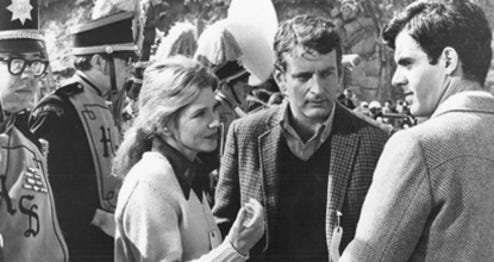
But the greatest shock to the people of Hot Springs was yet to come. When The Sporting Club came out in 1970, it premiered in Hot Springs at the local Sunset Drive In. The lines to get in to the screening stretched down Central Avenue and created a traffic jam, everyone was so excited to get to see themselves on the big screen. But few, if any of them, had read the script, let alone the novel, and what they watched that night left Hot Springs reeling.
The plot of The Sporting Club centers around a group of young adults whose parents are members of the exclusive lodge and who have grown disillusioned with the trappings of wealth and power it provides. They pull pranks on the members of the club all summer with the stakes ever increasing as the book and film progress. When a caretaker hired by the lodge is fired, he recruits his outlaw biker buddies to help him take out his revenge on the club. The bikers and the old millionaires each arm themselves for a showdown, and the war between the groups is a violent one. Peerce treats the violence with hyper-realism in the film, including a scene where an old man is tarred and feathered alive, and another where a man’s head is blown off with a gunshot to the mouth, which Peerce depicts in full gore - blood and teeth splattering across the screen in full color. The New Yorker’s critic Pauline Kael wrote of The Sporting Club: “Brutality is so self-righteously employed in this movie that it doesn’t make you hate brutality, it just makes you hate going to the movies. It has always been assumed that the mass movie audience enjoys violence, but I think recent movies have gone way past the audience’s pleasure threshold. When we are not expected to feel pity for the victim - not even when his flesh is smoking - the whole experience of moviegoing becomes ugly...This isn’t necessarily because we can’t face the truth, but, more likely, because most of the time now the movies’ attitude towards violence is, as in “The Sporting Club,” gloatingly exploitive.”
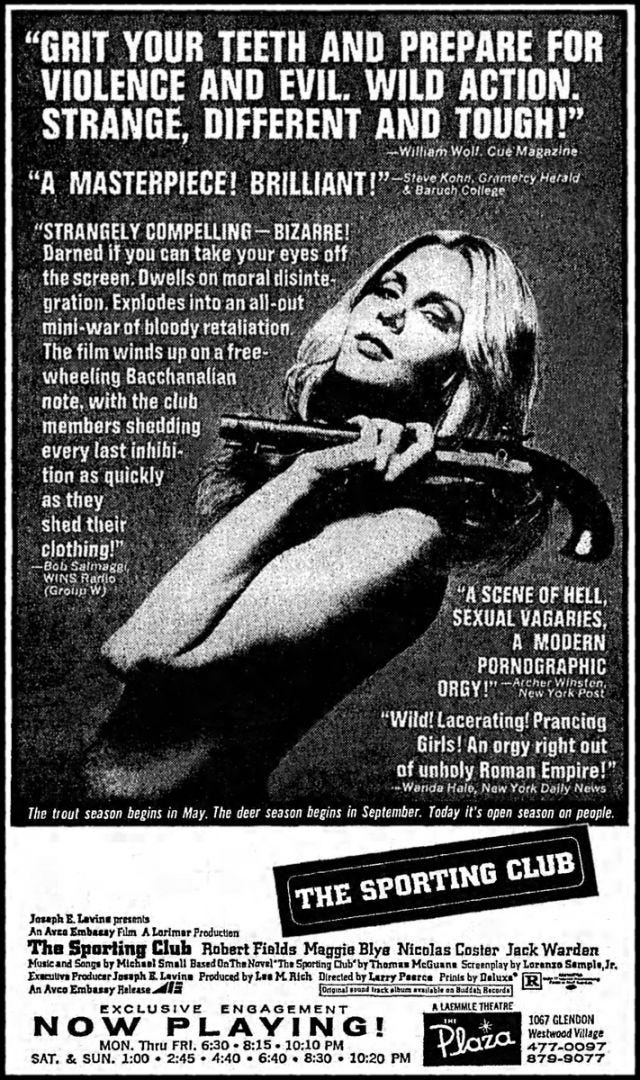
The film received mostly negative reviews, almost all focusing on the hyper-real violence and nihilistic tone. Peerce clearly wanted with this film to insert himself into a new class of avant-garde filmmakers inspired by the film Easy Rider, which dealt with similar themes as The Sporting Club. But his film received none of the critical praise of Dennis Hopper’s film, and the failure derailed what was considered a promising career. He tried and failed to adapt many other dark novels, such as The Bell Jar and A Separate Peace, both of which flopped. He later turned to directing made-for-TV movies.
While the violence and gore of The Sporting Club was shocking enough, what really sent the city of Hot Springs into a tizzy was the film’s final scene. After digging up a time capsule on the lodge’s property, the club’s members discover a photo of their ancestors - the founders of the club - engaged in a daisy chain. They learn that the club was more than just a sporting club, but a sex club for orgies. The film ends with a dream-like sequence where the camera whips around capturing all of the elderly members of the club undressing and engaging in a mass orgy, their wrinkled bodies bared and their sexual acts unspeakable. The only thing that saved the film from an X rating was the omission of any pubic hair, though it is debatable whether or not it actually succeeded on this front. The New York Times review of the film said of the final scene “we guarantee you've never seen such a repulsive array of flabby, middle-aged blubber.”
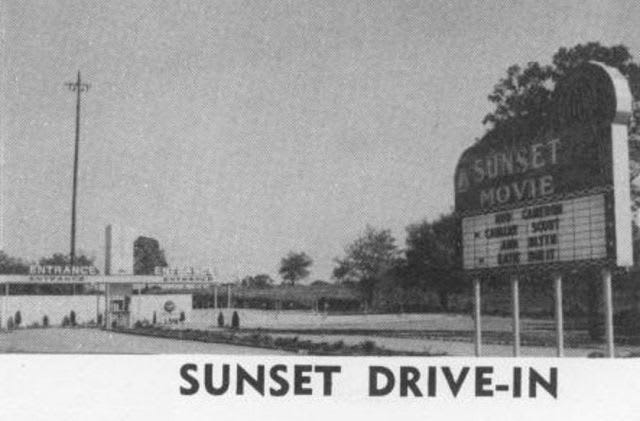
As the mayor of Hot Springs and his wife lead the procession out of the Sunset Drive In, the local citizenry were agog at what they had participated in. Across Hot Springs word got out that The Sporting Club was nothing more than “a porno” and those who played a role in it claimed they were duped about the film’s content. Despite Hot Springs’s recent reputation as the “sin city of the South,” this hippy avant garde brand of sin was a bridge too far.
After their experience with The Sporting Club, its likely the citizens of Hot Springs were on pins and needles for the release the next year of Two Lane Blacktop, another film shot partly outside of Hot Springs shortly before the release of The Sporting Club. They didn’t need to worry. Two Lane Blacktop, while still very much in the spirit of Easy Rider’s dark take on American culture in the 70s, had none of the gratuitous sex and violence of Peerce’s film. Despite starring James Taylor and Beach Boy Dennis Wilson, Two Lane Blacktop flopped even worse than The Sporting Club, with the studio refusing to even promote the film.
Like Boggy Creek II: And the Legend Continues, Two Lane Blacktop is often discussed and celebrated by Arkansans for being filmed there, despite their box office failures. Perhaps because both films became cult classics, one being revived by Mystery Science Theater 3000 and the other with a Criterion Collection re-release. But The Sporting Club has completely vanished from Arkansas lore, without even a mention in the Encyclopedia of Arkansas’s fairly exhaustive collection of films made in that state. Like a lot of the wonderfully sordid and scandalous history of Hot Springs, The Sporting Club has been swept under the proverbial rug forever. Those in Hot Springs who were around to experience the days of cross burnings and mobsters being murdered in the streets were happy to leave those days behind them and never speak of them again, just as they were happy to expunge the repulsive array of flabby, middle-aged blubber on their local drive-in screen from their collective memories. But while the Fouke Monster is just an Arkansas urban legend, The Sporting Club was very real. It may have been scary, but it happened. Someone out there knows the truth, even if they won't ever speak of it again.
Happy Halloween,
David


